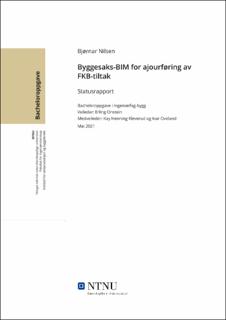| dc.contributor.advisor | Onstein, Erling | |
| dc.contributor.advisor | Kleverud, Kay Henning | |
| dc.contributor.advisor | Oveland, Ivar | |
| dc.contributor.author | Nilsen, Bjørnar | |
| dc.date.accessioned | 2021-08-03T10:08:02Z | |
| dc.date.available | 2021-08-03T10:08:02Z | |
| dc.date.issued | 2021 | |
| dc.identifier.uri | https://hdl.handle.net/11250/2765985 | |
| dc.description.abstract | Denne oppgaven belyser status og utfordringer i bruk av byggesaks-BIM for ajourføring av FKB-tiltak. Første del er litteraturstudie om dataflyten innen digital plan- og byggesaksbehandling, FKBtiltak, byggesaks-BIM og georeferering. Undersøkelsen består av intervju, analyse av 5 byggesaksBIM i Ifc4-format og testing av dataeksport fra byggesaks-BIM med Feature Manipulation Engine (FME). Intervjuene er gjennomført med 3 kommuner, 1 utbygger og 1 programvareutvikler. Hensikten med intervjuene er blant annet å si noe om status for bruk av byggesaks-BIM for ajourføring FKB-tiltak. Analysen av byggesaks-BIM består av å se på Ifc4-filene i et visningsprogram og et tekstredigeringsprogram. I visningsprogrammet vises 3D BIM-modellen og man har her sett etter objekter som er egnet for FKB-tiltak og hvordan disse er kodet. I tekstredigeringsprogrammet vises Ifc filstrukturen som tekst. Her har man analysert IfcSite og IfcMapConversion, to objekttyper som inneholder informasjon om georeferering. I testing med FME har man forsøkt å hente ut FKB-tiltaksflater/omriss og bygningspunkt fra byggesaks-BIM’ene. Disse har blitt importert i GIS.
De viktigste resultatene:
• Det kommer nesten ikke byggesaks-BIM inn til kommunene. Det er ikke grunnlag for å si noe om hvordan ajourføring fra byggesaks-BIM gjøres i praksis. Utbygger, på sin side, sier det er for vanskelig å lage byggesaks-BIM i DAK-verktøy og programvareutvikler sier det er vanskelig å lage programvare for ajourføring fordi testfilene ikke er entydig kodet. Alle aktører er positive til å bruke byggesaks-BIM for ajourføring FKB tiltak og har et ønske om å lykkes.
• Hvilke bygningselementer som skal brukes i FKB-tiltak er utvendige tak, vegger, ringmur og utstikkende objekter. Utfordringen er at disse objektene kodes ulikt i Ifcfiler. Dette gjør det tungvint å finne relevante objekter for FKB-tiltak i byggesaksBIM. Skal et dataprogram finne objekter, må koding gjøres entydig. En standard for hvilke objekttyper som skal brukes til FKB-tiltak og hvordan disse skal kodes er nødvendig.
• “Skallet” på en bygning er egnet for FKB-tiltak og egenskapen «IsExternal=yes/no» er et utvelgelseskriterium. Utfordringen er at denne egenskapen ofte kodes feil eller utelates.
• Byggesaks-BIM inneholder tilstrekkelig informasjon for å georeferere. Adresser, koordinater og referansesystem i IfcSite og IfcMapConversion plasserer representasjonspunkt riktig. Utfordringen er at FME ikke leser denne informasjonen automatisk. Koordinater for origo og skalering (millimeter til meter), måtte legges inn manuelt i «FME-Transformer». Det er usikkert hvordan FME leser EPSG-koder. | en_US |
| dc.description.abstract | This thesis sheds light on the status and challenges in the use of BIM-models for updating “FKB-project”. “FKB project” is the norwegian common, public map database for building projects. The first part is a literature study on the data flow within digital planning and construction case processing, “FKB-project”, BIM and georeferencing. The survey consists of an interview, analysis of 5 BIM-models in Ifc4-format and testing of dataexport with Feature Manipulation Engine (FME). The interviews were conducted with representatives from 3 municipalities, 1 developer and 1 software developer. The purpose of the interviews is to comment on the status of use of BIM for updating “FKB-project”. The analysis of BIM consists of looking at the Ifc4-files in a viewer and a text editor. The viewer helps display the 3D BIM-model and the search for objects that are suitable for “FKBproject” and how these are coded. In the text editor, the Ifc file structure is displayed as text. Here, IfcSite and IfcMapConversion have been analyzed, two object types that contain information about georeferencing. In testing with the FME, an attempt has been made to extract FKB intervention surfaces / outlines and building points from the BIM. These have been imported into GIS.
The most important results:
• Almost no BIM-models reaches the municipalities administration. There is no basis for saying anything about how updating from BIM-models is done in practice. Developer, for his part, says it is too difficult to create suitable BIM-models in CAD-tools and software developer says it is difficult to create software for updating because the test files are not equally coded. All actors are positive about using BIM for updating “FKB-project” and have a desire to succeed.
• Which building elements are to be used in “FKB-project” are external roofs, walls and protruding objects. The challenge is that these objects are encoded differently in Ifc-files. This makes it difficult to find relevant objects for “FKB-project” in the BIM-model. If a computer program is to find objects, coding must be made unambiguous. A standard for which object types are to be used for “FKB-project” and how these are to be coded is necessary.
• The “shell” of a building is suitable for “FKB-project” and the property “IsExternal = yes / no” is a selection criterion. The challenge is that this property is often coded incorrectly or omitted.
• BIM-models contains sufficient information to georeferencing. Addresses, coordinates and reference systems in IfcSite and IfcMapConversion position the representation point correctly. The challenge is that the FME does not read this information automatically. Coordinates for origin and scaling (meter / millimeter) had to be entered manually in “FMETransformer”. It is uncertain how the FME reads EPSG codes. | en_US |
| dc.language.iso | nob | en_US |
| dc.subject | BIM | en_US |
| dc.subject | Felles KartdataBase | en_US |
| dc.title | Byggesaks-BIM for ajourføring av FKB-tiltak: statusrapport | en_US |
| dc.type | Bachelor thesis | en_US |
| dc.subject.nsi | VDP::Technology: 500::Building technology: 530 | en_US |
| dc.source.pagenumber | 119 | en_US |
